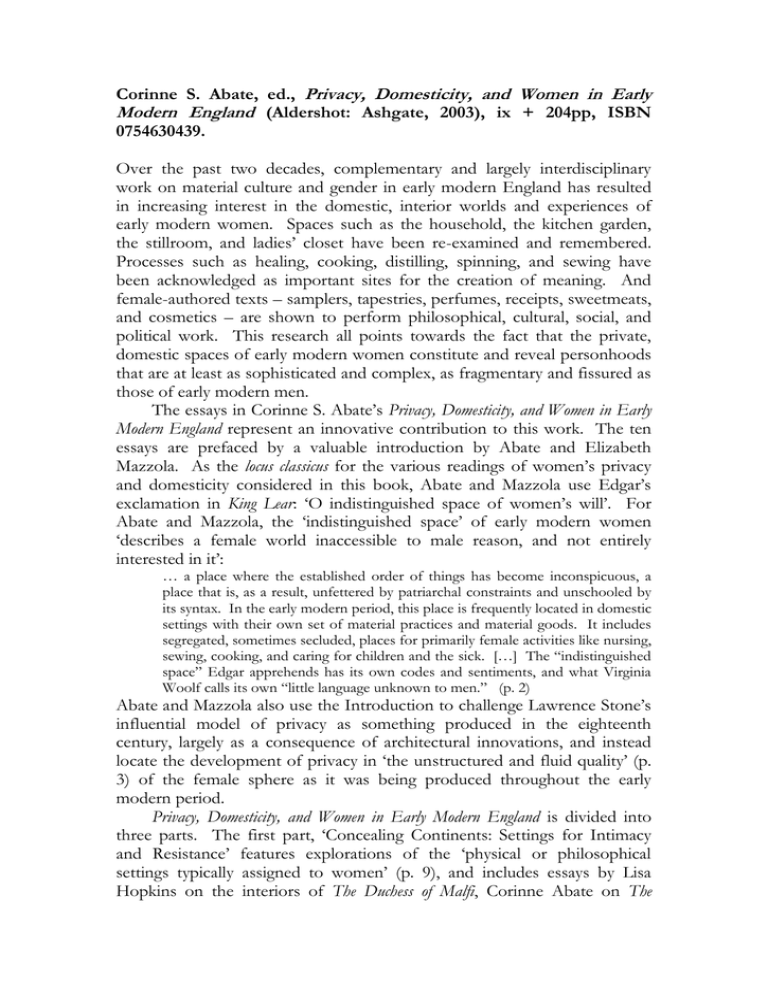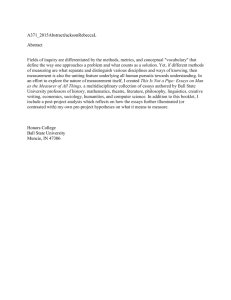Privacy, Domesticity, and Women in ... Modern England
advertisement

Corinne S. Abate, ed., Privacy, Domesticity, and Women in Early Modern England (Aldershot: Ashgate, 2003), ix + 204pp, ISBN 0754630439. Over the past two decades, complementary and largely interdisciplinary work on material culture and gender in early modern England has resulted in increasing interest in the domestic, interior worlds and experiences of early modern women. Spaces such as the household, the kitchen garden, the stillroom, and ladies’ closet have been re-examined and remembered. Processes such as healing, cooking, distilling, spinning, and sewing have been acknowledged as important sites for the creation of meaning. And female-authored texts – samplers, tapestries, perfumes, receipts, sweetmeats, and cosmetics – are shown to perform philosophical, cultural, social, and political work. This research all points towards the fact that the private, domestic spaces of early modern women constitute and reveal personhoods that are at least as sophisticated and complex, as fragmentary and fissured as those of early modern men. The essays in Corinne S. Abate’s Privacy, Domesticity, and Women in Early Modern England represent an innovative contribution to this work. The ten essays are prefaced by a valuable introduction by Abate and Elizabeth Mazzola. As the locus classicus for the various readings of women’s privacy and domesticity considered in this book, Abate and Mazzola use Edgar’s exclamation in King Lear: ‘O indistinguished space of women’s will’. For Abate and Mazzola, the ‘indistinguished space’ of early modern women ‘describes a female world inaccessible to male reason, and not entirely interested in it’: … a place where the established order of things has become inconspicuous, a place that is, as a result, unfettered by patriarchal constraints and unschooled by its syntax. In the early modern period, this place is frequently located in domestic settings with their own set of material practices and material goods. It includes segregated, sometimes secluded, places for primarily female activities like nursing, sewing, cooking, and caring for children and the sick. […] The “indistinguished space” Edgar apprehends has its own codes and sentiments, and what Virginia Woolf calls its own “little language unknown to men.” (p. 2) Abate and Mazzola also use the Introduction to challenge Lawrence Stone’s influential model of privacy as something produced in the eighteenth century, largely as a consequence of architectural innovations, and instead locate the development of privacy in ‘the unstructured and fluid quality’ (p. 3) of the female sphere as it was being produced throughout the early modern period. Privacy, Domesticity, and Women in Early Modern England is divided into three parts. The first part, ‘Concealing Continents: Settings for Intimacy and Resistance’ features explorations of the ‘physical or philosophical settings typically assigned to women’ (p. 9), and includes essays by Lisa Hopkins on the interiors of The Duchess of Malfi, Corinne Abate on The Taming of the Shrew, and Katherine Pratt on Mary Wroth’s Urania. Part 2, ‘Hospitable Favors: Rituals of the Household’, focuses on daily household activities and chores, and features Nancy A. Gutierrez on Ford’s The Broken Heart, Theodora A. Janowski on poems by Margaret Cavendish and Andrew Marvell, and Catherine G. Canino on The Faerie Queene. The final part, ‘Scanted Courtesies: Family Dynamics and Dispositions’ explores human interactions and relationships in the feminised worlds of privacy and domesticity, and includes essays by Elizabeth Mazzola on Queen Elizabeth I’s quasi-maternal relationship with Sir Philip Sidney, Sheila T. Cavanagh on female supernatural narratives in Urania, and Cristina León Alfar on King Lear. The contributors to this volume predominantly work within English literature, and all offer satisfying and subtle readings of representations of feminised interiors and domesticity within literary texts. This disciplinary focus is at once the strength and, perhaps, the chief weakness of this publication. Of all the essays, only three give consideration to writing by early modern women; two of them consider the same writer, Mary Wroth, who wrote in the ‘elevated’ literary genre of the prose romance. Perhaps with the notable exception of Janowski, who considers the poetic quality of cookery receipts, none of the essays give consideration to non-canonical literature and texts produced by women not simply within the household, but as a part of their household work. It is in these household texts, I think, that we might more fully witness Edgar’s ‘indistinguished space’ and read Virginia Woolf’s ‘little language unknown to men’ (p. 2). Jayne Archer University of Warwick



